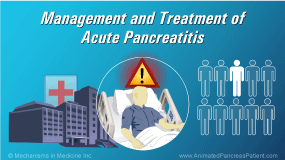Understanding Nutrition and the Role and Benefits of Pancreatic Enzyme Replacement Therapy (PERT)
*Please note: This slide set represents a visual interpretation and is not intended to provide, nor substitute as, medical and/or clinical advice.
The pancreas plays a pivotal role in normal food digestion. Pancreatic enzymes are produced by the pancreas and are essential for the digestion of fats, proteins, and carbohydrates.
Exocrine pancreatic insufficiency, or EPI, occurs when the pancreas becomes damaged and is no longer able to produce enough digestive enzymes to properly digest food, particularly fat and protein.
Consequently, people with EPI may not be absorbing important nutrients from their food that the body needs.
The disruption in the production and/or delivery of pancreatic enzymes can be caused by pancreatic diseases, pancreatic obstruction, pancreatic surgery, gastric surgery, bariatric surgery (for example gastric bypass with Roux en Y), or can be secondary to other medical conditions like celiac disease, inflammatory bowel disease, and diabetes which may also affect the pancreas.
Symptoms of EPI may include:
- Cramping or bloating after meals, large amounts of gas, foul-smelling gas or stools, floating stools, and greasy and/or oily, light colored stools, frequent loose stools, and unexplained weight loss.
- On occasion, patients may have an urge to go to the bathroom or may need to wake up from sleep to have a bowel movement.
If you experience some of these symptoms you should let your health care provider know. They may prescribe pancreatic enzyme replacement therapy, known as PERT, to help you properly digest food and manage your symptoms.
EPI is diagnosed based on a combination of the following:
- patient history (e.g., chronic pancreatitis or previous pancreatic surgery);
- patient symptoms (e.g., steatorrhea);
- and laboratory tests, such as a 72 hour stool collection for measurement of fat, or a fecal elastase test.
There are several brands of FDA-approved enzymes for PERT.
Over-the-counter varieties of pancreatic enzyme supplementation are also available, but these are not standardized or well regulated.
The number that accompanies the brand of enzyme corresponds to the number of 1000’s of units of lipase, amylase, and protease contained in each capsule. It is important to note this value so that the correct dose is taken.
Current FDA-approved pancreatic enzyme replacements are purified extracts from porcine pancreas.
The primary goals of PERT are to manage symptoms and improve nutritional status.
These goals can be achieved with correct dosing and timing of enzymes with all meals and snacks. This will in turn help you to achieve optimal nutrition from the foods you eat.
Even with the use of pancreatic enzymes, you may continue to have some intolerance to higher fat foods – particularly if you had a meal high in fat.
Your health care provider may refer you to a registered dietitian or nutritionist, who will help you plan your daily diet and will outline the optimal usage of enzymes with the food that you eat.
Dosing of pancreatic enzymes is based on your weight in kilograms. The dose will be determined for you by your health care team.
Some patients learn how to adjust the amount of enzymes based on their clinical symptoms and the amount of fat in the meal to be eaten.
Some key recommendations for taking PERT include:
- Take one dose of enzymes either at the beginning or middle of each meal, and another dose at the end of each meal. Larger meals may require more enzymes.
- A single dose of enzymes should also be taken with snacks.
- If applicable, time taking calcium- or magnesium-containing antacids or iron supplements separately from your enzymes by 1-2 hours.
- Acid reducing medications (such as H2 blockers or proton-pump inhibitors) may help to improve the effectiveness of enzyme activity. Ask your health care provider about these options.
Soon after starting the enzymes you will feel less bloating and gas after eating and your stools will begin to normalize. Abdominal pain frequently improves.
You will start to feel more energetic as you begin to absorb more of the nutrients that you eat. Frequently, patients regain some weight.
Occasionally pancreatic enzymes may not work. This may happen when too little enzyme is taken, or when enzymes are not taken with food.
This may also happen when there is intestinal bacterial overgrowth, or if the patient has had previous surgery. Your health care provider can work with you to provide advice and supplementary support.
PERT are safe medications but some reported side effects include: abdominal cramps, nausea, constipation, or diarrhea. Most of the published data has shown no difference in side effects when compared to placebo.
It is important to take into consideration side effects from other medications that are being taken, as these may be mis-attributed to PERT.
If your health insurance does not cover the cost of PERT, ask your health care team about patient assistance programs.
For the majority of patients taking PERT, there is a significant improvement of symptoms, nutritional status, and overall quality of life.


























